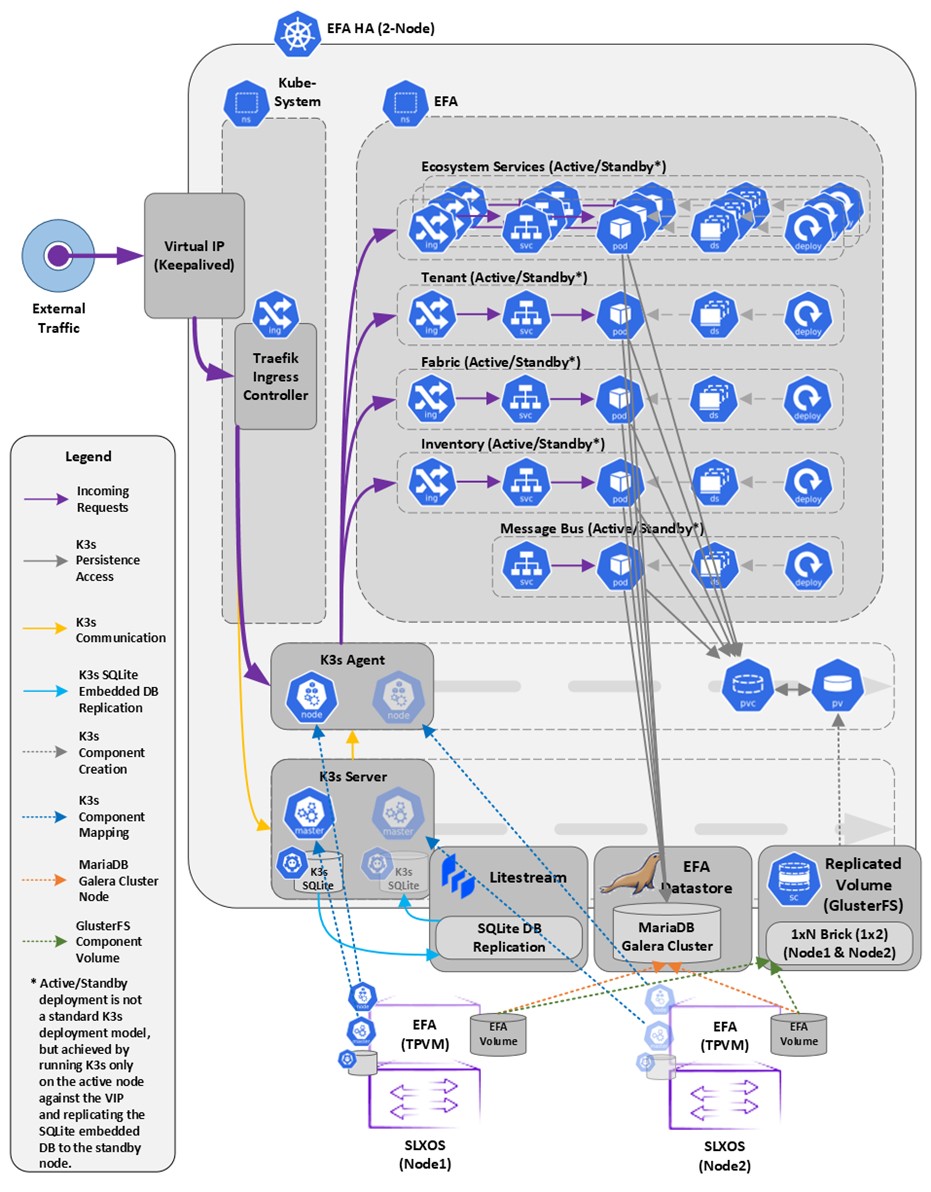EFA Deployment for High Availability
You can deploy EFA in a two-node cluster for high availability.
Overview
A high-availability cluster is a group of servers that provide continuous up time, or at least minimum down time, for the applications on the servers in the group. If an application on one server fails, another server in the cluster maintains the availability of the application.
In the following diagram, EFA is deployed in the TPVM running on SLX-OS. The two EFA instances are clustered and configured with one IP address, so that clients need to reach only one endpoint. All EFA services are installed on each node. The node on which EFA is installed is the active node and processes all requests. The other node is the standby. The standby node runs processes all the requests when the active node fails.

All operations provided by EFA services must be idempotent, meaning they produce the same result for multiple identical requests or operations. For more information, see the "Idempotency" section of the Extreme Fabric Automation Administration Guide, 2.7.0 .
EFA uses the following services to implement an HA deployment:
- Keepalived (VRRP) – It is a program which runs on both nodes. The active node frequently sends VRRP packets to the standby node. If the active node stops sending the packets, keepalived on the standby assume the active role. Thus, the standby node becomes the active node. Each state change runs a keepalived notify script containing logic to ensure EFA‘s continued operation after a failure. With a two-node cluster, a ”split-brain” may occur due to a network partition which leads to two active nodes. When the network recovers, VRRP establishes a single active node that determines the state of EFA.
- K3s – In EFA 2.7.0, a k3s server runs on the active node. Kubernetes state is stored in SQLite and is synced in real-time to the standby node using a dedicated daemon, litestream. On a failover, the keepalive notify script on the new active node reconstructs the Kubernetes SQLite DB from the synced state and starts the k3s. In EFA 2.7.0, k3s runs on one node at a time, not on both nodes and hence the HA cluster looks like a single-node cluster, however, the HA cluster ties itself to the keepalived-managed virtual IP.
- MariaDB and Galera – EFA business states (device, fabric, and tenant registrations and configuration) are stored in a set of databases managed by MariaDB. Both the nodes run a MariaDB server, and the Galera clustering technology is used to keep the business state in sync on both the nodes during normal operation.
- Glusterfs – This is a clustering filesystem used to store EFA‘s log files, various certificates, and subinterface definitions. A daemon runs on both the nodes which seamlessly syncs several directories.

Note
Although Kubernetes run as a single-node cluster tied to the virtual IP, EFA CLIs still operate correctly when they are run from active or standby node. Commands are converted to REST and issued over HTTPS to the ingress controller via the virtual IP tied to the active node.
EFA 2.7.0 de-emphasizes Kubernetes-specific outputs in its various informational CLIs. The SLX show efa status command now more closely matches the TPVM efa status command.
The efa status command becomes more conservative when you declare the EFA as fully operational. It confirms the following:
- For the active node:
- All enabled EFA services are reporting Ready
- Kubernetes state is consistent with all the enabled EFA services (for example, service endpoints exist)
- The host is a member of the Galera or MariaDB cluster
- For the standby node:
- It is reachable via SSH from the active node
- It is a member of the Galera or MariaDB cluster
- For both the nodes:
- The Galera cluster size is 2 if both the nodes are up, and the cluster size is >= 1 if the standby node is down.
The efactl utility is updated
in the following ways:
efactl startwaits for all the started services to report Ready before terminating. You can achieve an asynchronous operation by backgrounding the command from the shell.efactl stop-serviceterminates all the selected EFA services. If you restart the EFA cluster, run a subsequent efactl start-service command to restart the stopped services.
- PV: Persistent Volume
- A piece of storage in the cluster that was provisioned by an administrator.
- PVC: Persistent Volume Claims
- A request for storage, similar to how a Pod requests compute resources.
- Brick
- The basic unit of storage in GlusterFS, represented by an export directory on a server in the trusted storage pool.
- SC: Storage Class
- A description of the “classes” of storage in a Kubernetes realm.
- SVC: Kubernetes Service
- A logical set of Pods and a policy by which to access them.
- ING: Kubernetes Ingress
- A collection of routing rules that govern how external users access services running in a Kubernetes cluster.
- RS: Kubernetes Replica Sets
- Ensures how many replicas of a Pod should be running.
- K3s
- Manages the life cycle of the EFA services in failover or fallback scenarios.
- Traefik
- An embedded ingress controller (load balancer) packaged with K3s.
- GlusterFS
- A high-availability replicated volume that maintains the persistent storage for the K3s cluster, the EFA database, and EFA logs.
- MariaDB
- A database service deployed outside of the K3s cluster in active-standby mode.
- RabbitMQ
- A messaging service deployed in the cluster in active-active mode.
Services in high-availability mode
EFA services running on K3s are in active-standby mode.

